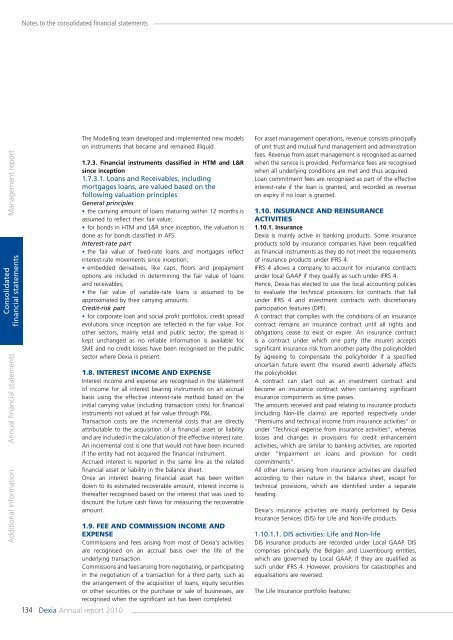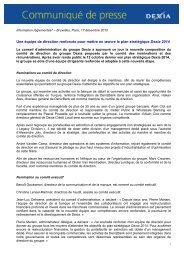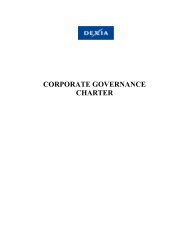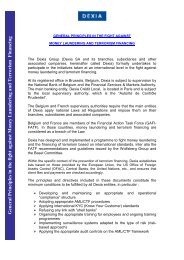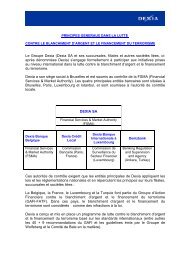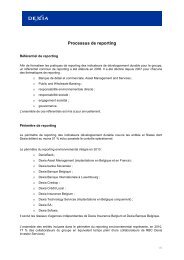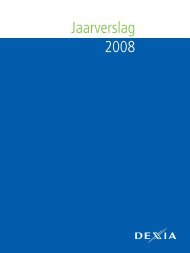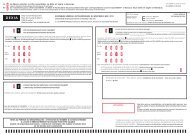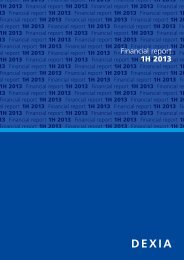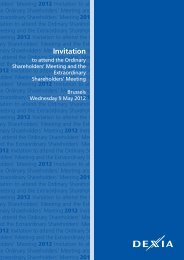Annual report 2010 - Dexia.com
Annual report 2010 - Dexia.com
Annual report 2010 - Dexia.com
- No tags were found...
Create successful ePaper yourself
Turn your PDF publications into a flip-book with our unique Google optimized e-Paper software.
Notes to the consolidated financial statementsManagement <strong>report</strong>Consolidatedfinancial statementsAdditional information <strong>Annual</strong> financial statements134 <strong>Dexia</strong> <strong>Annual</strong> <strong>report</strong> <strong>2010</strong>The Modelling team developed and implemented new modelson instruments that became and remained illiquid.1.7.3. Financial instruments classified in HTM and L&Rsince inception1.7.3.1. Loans and Receivables, includingmortgages loans, are valued based on thefollowing valuation principlesGeneral principles• the carrying amount of loans maturing within 12 months isassumed to reflect their fair value;• for bonds in HTM and L&R since inception, the valuation isdone as for bonds classified in AFS.Interest-rate part• the fair value of fixed-rate loans and mortgages reflectinterest-rate movements since inception;• embedded derivatives, like caps, floors and prepaymentoptions are included in determining the fair value of loansand receivables;• the fair value of variable-rate loans is assumed to beapproximated by their carrying amounts.Credit-risk part• for corporate loan and social profit portfolios, credit spreadevolutions since inception are reflected in the fair value. Forother sectors, mainly retail and public sector, the spread iskept unchanged as no reliable information is available forSME and no credit losses have been recognised on the publicsector where <strong>Dexia</strong> is present.1.8. INTEREST INCOME AND EXPENSEInterest in<strong>com</strong>e and expense are recognised in the statementof in<strong>com</strong>e for all interest bearing instruments on an accrualbasis using the effective interest-rate method based on theinitial carrying value (including transaction costs) for financialinstruments not valued at fair value through P&L.Transaction costs are the incremental costs that are directlyattributable to the acquisition of a financial asset or liabilityand are included in the calculation of the effective interest rate.An incremental cost is one that would not have been incurredif the entity had not acquired the financial instrument.Accrued interest is <strong>report</strong>ed in the same line as the relatedfinancial asset or liability in the balance sheet.Once an interest bearing financial asset has been writtendown to its estimated recoverable amount, interest in<strong>com</strong>e isthereafter recognised based on the interest that was used todiscount the future cash flows for measuring the recoverableamount.1.9. FEE AND COMMISSION INCOME ANDEXPENSECommissions and fees arising from most of <strong>Dexia</strong>'s activitiesare recognised on an accrual basis over the life of theunderlying transaction.Commissions and fees arising from negotiating, or participatingin the negotiation of a transaction for a third party, such asthe arrangement of the acquisition of loans, equity securitiesor other securities or the purchase or sale of businesses, arerecognised when the significant act has been <strong>com</strong>pleted.For asset management operations, revenue consists principallyof unit trust and mutual fund management and administrationfees. Revenue from asset management is recognised as earnedwhen the service is provided. Performance fees are recognisedwhen all underlying conditions are met and thus acquired.Loan <strong>com</strong>mitment fees are recognised as part of the effectiveinterest-rate if the loan is granted, and recorded as revenueon expiry if no loan is granted.1.10. INSURANCE AND REINSURANCEACTIVITIES1.10.1. Insurance<strong>Dexia</strong> is mainly active in banking products. Some insuranceproducts sold by insurance <strong>com</strong>panies have been requalifiedas financial instruments as they do not meet the requirementsof insurance products under IFRS 4.IFRS 4 allows a <strong>com</strong>pany to account for insurance contractsunder local GAAP if they qualify as such under IFRS 4.Hence, <strong>Dexia</strong> has elected to use the local accounting policiesto evaluate the technical provisions for contracts that fallunder IFRS 4 and investment contracts with discretionaryparticipation features (DPF).A contract that <strong>com</strong>plies with the conditions of an insurancecontract remains an insurance contract until all rights andobligations cease to exist or expire. An insurance contractis a contract under which one party (the insurer) acceptssignificant insurance risk from another party (the policyholder)by agreeing to <strong>com</strong>pensate the policyholder if a specifieduncertain future event (the insured event) adversely affectsthe policyholder.A contract can start out as an investment contract andbe<strong>com</strong>e an insurance contract when containing significantinsurance <strong>com</strong>ponents as time passes.The amounts received and paid relating to insurance products(including Non-life claims) are <strong>report</strong>ed respectively under“Premiums and technical in<strong>com</strong>e from insurance activities“ orunder “Technical expense from insurance activities“, whereaslosses and changes in provisions for credit enhancementactivities, which are similar to banking activities, are <strong>report</strong>edunder “Impairment on loans and provision for credit<strong>com</strong>mitments“.All other items arising from insurance activities are classifiedaccording to their nature in the balance sheet, except fortechnical provisions, which are identified under a separateheading.<strong>Dexia</strong>'s insurance activities are mainly performed by <strong>Dexia</strong>Insurance Services (DIS) for Life and Non-life products.1.10.1.1. DIS activities: Life and Non-lifeDIS insurance products are recorded under Local GAAP. DIS<strong>com</strong>prises principally the Belgian and Luxembourg entities,which are governed by Local GAAP, if they are qualified assuch under IFRS 4. However, provisions for catastrophes andequalisations are reversed.The Life Insurance portfolio features:


